
Care & Culture—A Guide to Growing Fuchsias
Hmm... Just how much do they eat and drink?
Hmm... Just how much do they eat and drink?
Watering & Feeding
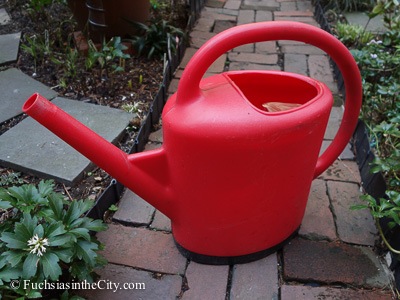
Beyond these basic requirements, evenly moist but not wet, are a number of tips and techniques you might find useful in getting your plants to give the best performances they can.
Hanging baskets are especially prone to drying out quickly so they might need to be checked again in the afternoon on warm or dry days. They're positioned higher and are exposed to more of the drying effects of wind. This is often the case in my garden, where I have good breezes that come down between the buildings and pass through the hanging baskets. Large mature trailing plants in hanging baskets have significantly more leaf area in proportion to the amount of roots as well. This abundance of leaves will drain the available moisture from the soil much more rapidly than smaller plants will.
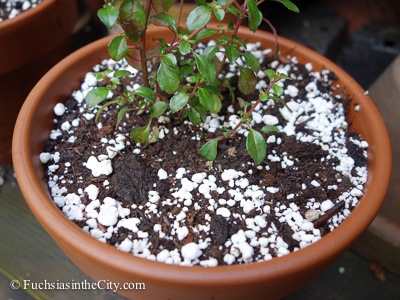
The leaves of many plants, of course, will wilt if the plant becomes too dry. Fuchsia leaves might also droop a bit in the heat of a high-summer afternoon or if grown in a sunnier spot. In addition, fuchsias stop actively transpiring moisture through their leaves when the temperatures rise much above the upper 70's or low 80's Fahrenheit (25 to 30 C) .
Because of this behavior, it's important to actually check the soil of your plants before you add water if you see wilting leaves. Only add water if the soil's dry. Simply adding more water not needed will not cause the leaves to perk back up. At these times, it's best to mist the leaves and surrounding areas to cool down the plants instead. You'd be surprised just how effective misting can be in getting fuchsias to perk back up in the heat.
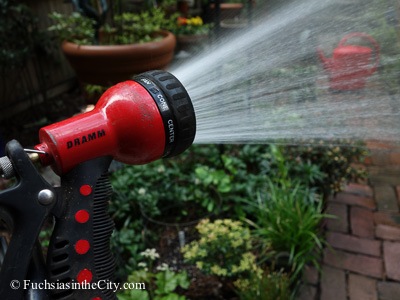
Fuchsias are usually described as gross feeders. No matter how rich it was when it first started out, the frequent watering of pot culture will quickly leech important nutrients from the potting mix. A soilless mix might not contain much nutrition for the plants anyway. So the supplemental feeding of fuchsias can start fairly soon after they're potted up and growing on. It's best to avoid feeding plants that have just rooted, though, since you stand a chance of burning tender young roots.
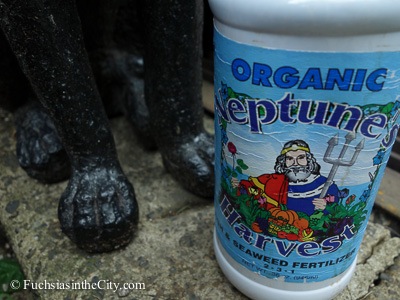
Personally, I feed my plants about once a week and find that they respond just fine to that schedule. The exact proportions depend on the brand. For example, if the instructions say to add a tablespoon of food to every gallon of water and apply it once a month, I'll quarter that, or often even a little less, to apply it weakly and weekly. I also make sure that it's thoroughly dissolved and stirred about before I give to the plants.
Some liquid plant food is good for foliar feeding and I regularly sprinkle some of the weak solution over the leaves from the rose of my watering can. Fuchsias should not be feed when their soil is dry, though. In that case, I might water first or wait until a little later in the day to water the plant food in. Towards the end of the season, I'll stop feeding the plants as I want to slow their growth and prepare them for over-wintering.
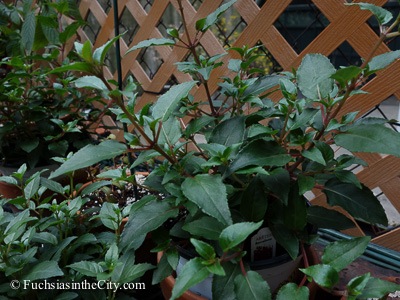
Since you generally want to encourage good root growth, strong stems and good flowering in fuchsias, a formulation that's higher in phosphorus and especially potassium, such as the tomato food, is good. Be aware that potassium also tends to wash out of the soil faster than phosphorus. During the height of the summer, fuchsias might benefit from a formulation that's a little bit higher in nitrogen to help maintain leaf growth.

I have a hesitation with the current trend of big business to add fertilizer to just about every product. Perhaps it's being driven by the desire to sell, sell, sell to the uniformed from the shelves of box stores but it seems like an arms race has taken over to add junk food for plants as a selling point of supposed convenience. I don't like the one-size-feeds-all-for-the-season strategy of additives being so helpfully foisted in a potting mix.
Many fertilizers can burn new roots. What's in the mix? Will it assault new fuchsia roots as they're developing? Exactly how long does it last? Will it deplete and set back my fuchsias' growth before I notice and can make up for the deficiency with my own feeding? What are these products really good for?
I suspect that the New Improved Triple-Action No-Thought-No-Effort Potting Mix Now with Broadcide®™ might mostly be good for the bottom line of super-corporations but I don’t think it’s especially beneficial for my gardening or my fuchsias. I tend to pass these enriched season's-pass potting mixes by in favor of my own feeding program.
Chapter III
Propagating & Potting Up
Propagating & Potting Up
Chapter IV
Growing On
Growing On
Chapter V
Watering & Feeding
Watering & Feeding
Chapter VI
Pinching & Shaping
Pinching & Shaping
Chapter VII
Special Shapes
Special Shapes